DISEASE IN JAPANESE STILTGRASS SPREADS THROUGH REGION
Since the summer of 2009, when it was first described as sickening and killing Japanese stiltgrass in Calhoun County woodlands, a disease now identified as being caused by a species of Bipolaris fungus has spread through Japanese stiltgrass plants on infested properties throughout the Appalachian region.
Research to learn specific details about Bipolaris has barely begun and most questions about the disease have yet to be answered. Because Bipolaris causes so much damage to the foliage of Japanese stiltgrass, seed production in infected populations is reduced and the number of stiltgrass seedlings germinating also drops. However, because the discovery of Bipolaris in Japanese stiltgrass is so recent, it may take several years to determine whether the disease will be persistent enough to have the long term impact of stifling the colonization and spread of what is now recognized as one of the most widespread and environmentally destructive invasive plants in the eastern half of the US.
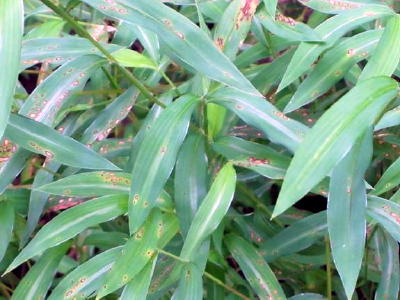
Bipolaris infected stiltgrass can have numerous spots that first
appear as very small purple lesions that grow larger over time.
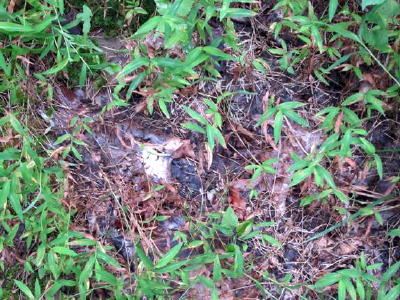
As the disease progresses in Japanese stiltgrass, the lower
leaves of the plants will start to die and the thickness of
the foliage thins to the point where the natural ground surface
becomes visible and other plants that were once shaded by
stiltgrass respond to increased sunlight and begin to grow.
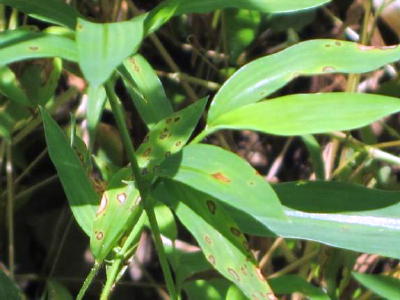
The newly named fungus species appears to be native to our region
but had never been identified until it started killing Japanese
stiltgrass. The same species of Bipolaris fungus infecting Japanese
stiltgrass has now been identified as present in live samples of
several species of local woodland plants, including black Cohosh and
there is growing evidence that Bipolaris may cause lesions on the
foliage of other species of native plants including several grasses.
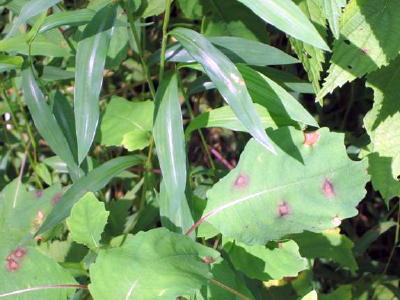
In many areas where Bipolaris is very active other plants are
showing similar symptoms. Research to understand what plants
besides Japanese stiltgrass are affected by the disease has not yet
begun. These jewelweed (touch-me-not) plants have spots similar to
those on stiltgrass but the plants appear to be otherwise healthy.
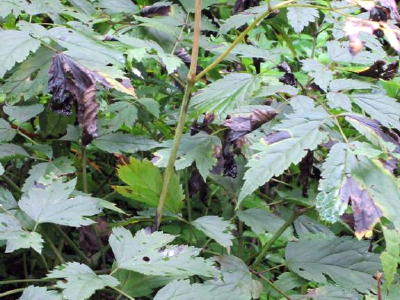
Black Cohosh is a commercially important medicinal plant that can be found growing in fertile woodland throughout Calhoun and neighboring counties. Researchers have found Bipolaris in black Cohosh but one of the most common foliage diseases that attacks black Cohosh is called Rhizoctonia and caused by another kind of fungus. There has been no research to find whether this damage to local black Cohosh plants is caused by Bipolaris or Rhizoctonia or a combination of both.
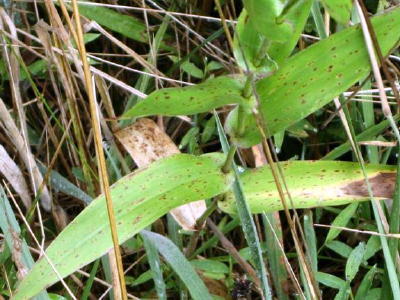
Several species of deertongue, a perennial native grass are also showing signs of being infected by Bipolaris. Japanese stiltgrass is an annual plant meaning that the plant completes its life cycle in a single growing season. It is not known how the disease will affect the perennial native grasses that are important to local wildlife for food or shelter.
As soon as Bipolaris was discovered in Japanese stiltgrass, scientists mentioned concerns that Bipolaris is also related to some of the most serious diseases in corn and several other important agricultural crops and idea of using Bipolaris for the biological control of stiltgrass was dropped from consideration. However, the unexpected and rapid spread of the disease through regional Japanese stiltgrass populations has uncorked the biocontrol bottle and let the Bipolaris genie loose. We can only hope that Bipolaris proves to be as harmful to the long term survival of Japanese stiltgrass as the most optimistic situations indicate, but only time will tell.
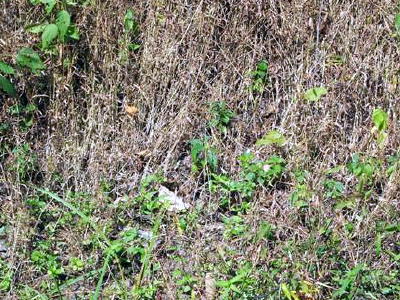
In the meantime, property owners and natural resource managers throughout the Appalachians are hoping to someday see the Japanese stiltgrass on their land look like this.